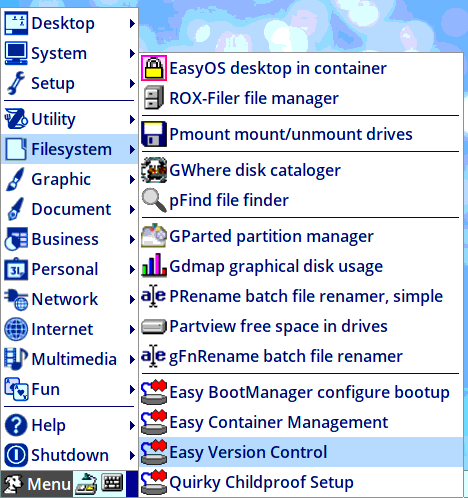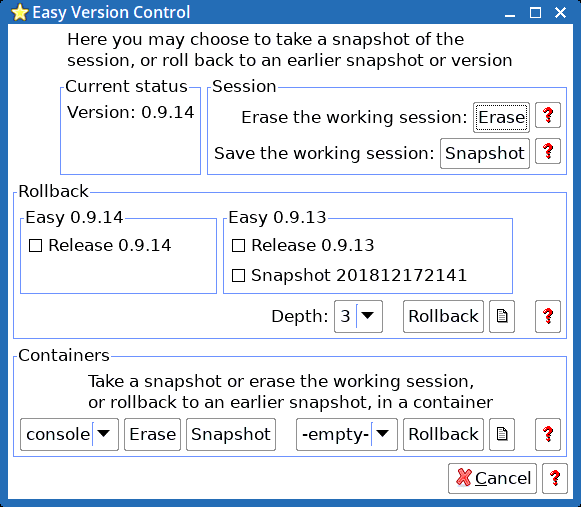Easy version upgrade and downgrade
Page updated March 17, 2019. Page updated August 11,
2020
Page updated June 18, 2022
A significant feature of EasyOS is the ease of updating to new
versions, and rollback to older versions and snapshots, and
roll-forward again.
Updating
Updating is very easy. On the desktop there is an icon labeled
"update"; click on that, and the latest version of EasyOS is
downloaded and installed. You then reboot, and that's it, you have
updated. Here is the "update" icon:
![]()
A great thing about EasyOS is that updating is an "atomic"
operation: there are just three files required to upgrade;
'vmlinuz', 'initrd' and 'easy.sfs'. Replace those with the
latest, and version update is done. That, essentially, is what
"update" does.
If you would like to read more details about the update
process, there is a web-page:
https://easyos.org/user/how-to-update-easyos.html
As well as updating, you can rollback and roll-forward...
Version management
After rebooting, you will be running the new version, The
snapshot below shows an older upgrade, the Author upgraded from
0.9.13 to 0.9.14.
It is fruitful to have a look around in the 'releases' and 'sfs'
folders in the working-partition -- you will see that the older
versions are still there.
Technical note:
The working-partition and working-folder may be something like /mnt/sdb2/easyos/; however, for your convenience, /mnt/wkg is a symlink to it.
As older versions are retained, it means that you can roll back
to an earlier version if desired, or to any earlier snapshot.
There is a GUI to handle this, via the "Filesystem" menu:

And here is Easy Version Control:

...in this example, the Author had created one snapshot,
"Snapshot 201812172141". The other one, "Release 0.9.13" is the
status at first startup of version 0.9.13.
"Release 0.9.14" is the status at first startup of version
0.9.14.
The really great thing is, you can roll forwards and backwards to
any of these "Release*" and "Snapshot*" status captures.
Technical note:
What is being referred here as the "status" is the content of the /mnt/wkg/.session folder, which is the read-write folder in the aufs|overlay layered filesystem.
Note the little button with picture of a page -- click on that to
see commentary on snapshots, which makes it easier to decided what
snapshot you might like to roll back/forward to.
Note also, the "Depth" parameter, set to "3". This means that the
history is set to only three versions. When you make the fourth
version upgrade, the oldest one is deleted. This is to save space.
If you have Easy installed in a large working-partition, you
could increase that depth. Not that most users would want to roll
back many versions, but it is something that developers might want
to do.
The secret of such easy upgrading and downgrading is, of course,
due to everything being in a single squashfs file, 'easy.sfs' (and
use of the aufs|overlay filesystem). Unlike many other
distributions that have to do a per-package
update.
Tags: user
